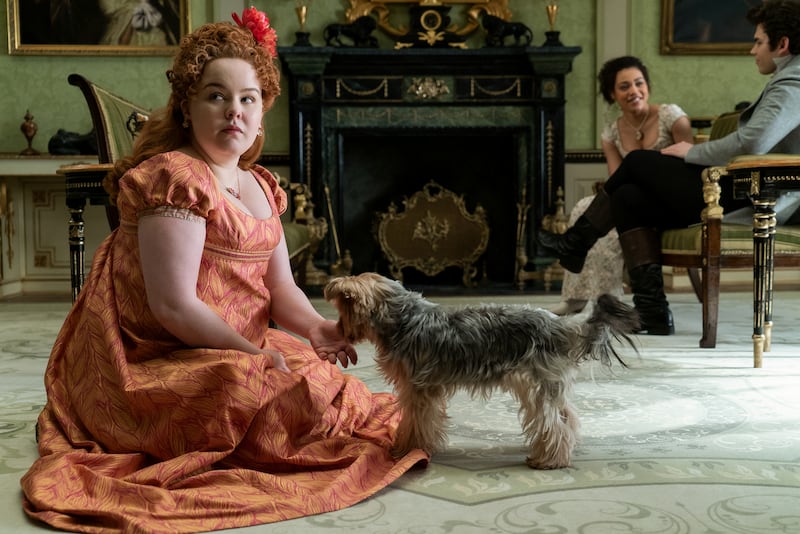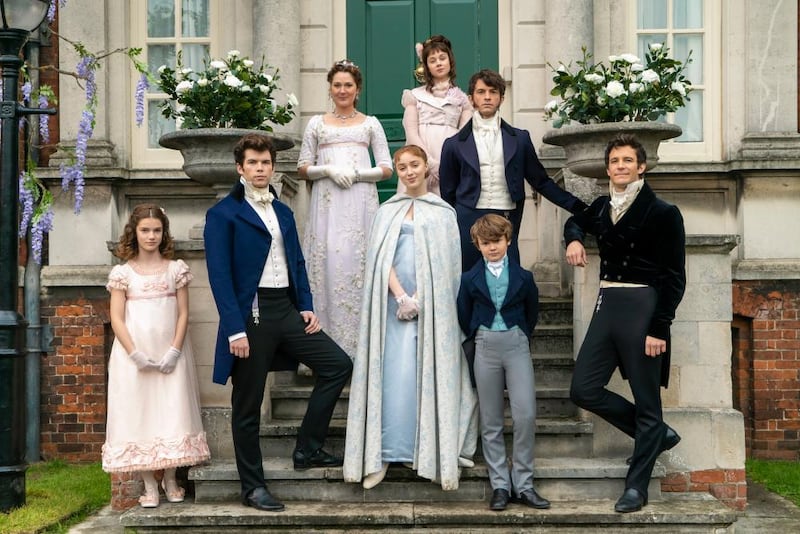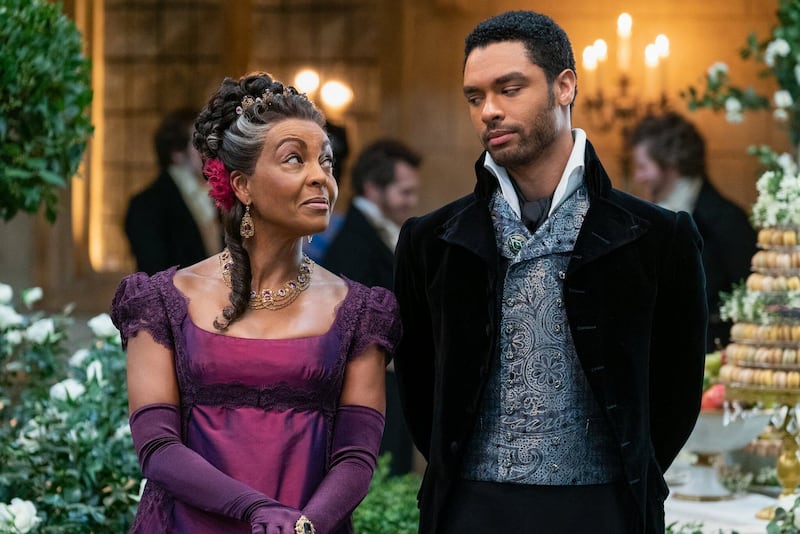‘It sees the Regency period through American eyes’
By Lanre Bakare
Christmas 1995 was one to forget. I was ill and mostly confined to the sofa, trying to keep down mince pies as my big sister made her way through the VHS release of Andrew Davies’ Pride and Prejudice. A few years earlier, I had been subjected to the Julian Amyes version of Jane Eyre starring Timothy Dalton, but at least that was weirdly gothic and unintentionally hilarious; this was another level.
Pemberley, Mr Bingley, Jennifer Ehle with her bonnet, Colin Firth in a pond. For an 11-year-old who liked WWF and Rage Against the Machine, it was like water torture. The experience put me off costume dramas and Austen for years. Any sign of buttoned-down, stiff-upper-lip, no-sex-we’re-British Regency nonsense was anathema to me.
Then, 25 years later, Bridgerton turned up on Christmas Day. Unapologetically daft, it luxuriates in playing with the form and conventions of costume dramas, instilling them with modern storytelling chops and the sort of overblown production I last saw in Sofia Coppola’s Marie Antoinette.
To say Bridgerton is the height of representation would be silly – the characters of colour are not treated well and have little agency
It sees the Regency period through American eyes, highlighting the things that people like most about British aristocratic tropes: the grandeur, the pomp and the gilded cages. The repressed sexuality is still on show, but it is countered by unapologetically rampant bonking and homoerotic boxing.
But the show is about far more than sex and siring heirs. Bridgerton even managed to make me interested in the logistical problems of 19th-century aristocrats. How do you cope when you have wasted your daughters’ dowry on ill-advised wagers? Why do the townsfolk recoil in horror when m’lady refuses to choose a pig for the slaughter?
What about hiding the tell-tale bump of a forthcoming illegitimate child when you have a ball to attend? One of the best scenes is when Daphne confronts her mother after she doesn’t tell her about the intricacies of the birds and the bees. Yes, that sounds utterly ridiculous when written down, but the Shondaland framing manages to make it compelling.
I don’t think I will be reaching for the Pride and Prejudice VHS any time soon, but Bridgerton has made me – and probably thousands of others – reconsider what a costume drama can be.

‘A regency rollick that felt eerily prescient to the pandemic’
Jenny Stevens
Bridgerton is a romp – in all senses of the word. Take the very first scene, where the debutante Daphne waits to be escorted to London by her brother, while we see him pants-at-knees humping an opera singer against a tree. It is an impressive amount of bottom in the first three minutes – you didn’t get this in Cranford, but then nor did you get an orchestral reimagining of Ariana Grande as a soundtrack.
And so begins this very modern period drama; a romantic rollick set in 1813 London that feels eerily prescient to contemporary pandemic Britain. It is courting season on Grosvenor Square, where “titled, chaste and innocent” girls flounce into the capital to find – or be thrust upon, or laden down with – a respectable male suitor. Potential matches meet with chaperones, often in public spaces, and touching is strictly forbidden.
It is not exactly the same as illicitly meeting up with a Hinge or Tinder match and pretending to do “exercise” around the local park, but nor does it feel so very far removed. It made me wonder whether, in 2227, viewers will watch London’s singletons, in knockoff Moncler duvet coats with woolly hats and Thermoses, endure socially distanced park-bench dates while hoping for a sneaky touch on the arm, in a period drama about the great pandemic courting season of 2020/21.
Shonda Rhimes, the Bridgerton producer, has quenched a thirst in bleak times, not just for a bit of fluff, pomp and drama to soothe tired new year minds, but for the recognition that chastity is very hard, strict social rules make people miserable and that some people will inevitably break them – especially the moneyed and powerful.
She has also managed to balance the audience’s gaze on the male and female body equally. It is rare to find on-screen depictions of sex where the men are as unclothed as the women. Here, there are more male tops off than the 1994 Take That European tour; it takes a bit of time to adjust to seeing the Viscount Bridgerton fully dressed.
As lockdown continues and the absence of touch is felt even more cruelly, Bridgerton – with its circus of secret trysts, gossip and drama – is a perfect balm for those at home, alone, with a long winter ahead.

‘I didn’t know I liked period dramas because I’d never before seen someone like me in one’
Poppy Noor
I have a rule about TV. If there are no people of colour in a show, I try not to watch. However, this rule, despite its many benefits – I watch less TV than I otherwise would and have an excuse for refusing to watch many of Judd Apatow’s films – has confused me into thinking I didn’t like period dramas.
I now realise this is untrue. Bridgerton has taught me that I do like period dramas – I was just put off by the near-total whiteness. Period dramas are supposed to speak to all women – thanks to the supposedly universal themes of women being treated like a doormats. But as the Guardian TV critic Ellen E Jones wrote, while talking about Fleabag: “Art that’s most often ascribed this kind of universality actually comes from the specific perspective of the dominant class. ‘Posh girls’, for short.” To this I would add only that this almost always means “posh white girls”, so you’ll understand why I didn’t vibe with period dramas before now.
But who can resist the themes of scandal, betrayal and stupid men? In Bridgerton, these three things are cleverly combined with an element of mystery: a gossip columnist called Lady Whistledown informs high-society London (AKA “the ton”) of all three, by mail every week – and of course everyone, the viewers included, want to know who she is.
Bridgerton is an undoubted success. It has heart. It has goodies and baddies getting their dues
Brown people have been around in England for a while (Cheddar man, anyone?). Yet TV and film have long been happy to whitewash not just history, but also fiction – see the endless debates about whether fictional characters can be played by a person of colour (eg James Bond) and the lack of shame around casting white actors as brown people (see Ridley Scott’s Exodus: Gods and Kings).
To say Bridgerton is the height of representation would be silly – the characters of colour are not treated well and have little agency. The Duke of Hastings is tricked by his wife, first into marrying her, then into having unprotected sex with her – which some critics have called sexual assault (a more clearcut theme in the book than the TV version). He does not want children (telling her, before they are married, that he “cannot” have them), but she then wields the power of the dictionary to fight this, insisting she had misconstrued his words and thought he was impotent. “Cannot is different to will not!” she proclaims.
Marina Thompson, meanwhile, the beautiful black woman sent to live with the unremarkable Featheringtons, is subject to scorn, jealousy and ultimately revenge for being desirable. Queen Charlotte, played by an actor of colour in a nod to the conjecture that she may have been mixed race, pines for her mentally ill husband. (Others have pointed out that all the characters of colour who are love interests are light-skinned.) The only black character you don’t feel pity for is Lady Danbury, who, quite simply, is the role model you wish you had.
The show suggests that the king marrying a black woman removed racial inequalities in the 19th-century – which, well, you only have to look at what happened to Meghan and Harry in the 21st century to know that utopia hasn’t arrived. Race is rarely mentioned. Then again, justifying brown characters in a show by adding a bit about “people-of-colour issues” is not exactly revolutionary.
Bridgerton is watchable if ultimately predictable. If it were another show, I wouldn’t write about it. But to see people like me allowed to star in a genre that is usually cordoned off tricked me into exploring a world I never get to see on screen. I am not landed gentry or nobility, but I am a person of colour, and I have never, until this year, seen myself in a period drama (hats off to The Great, also). Perhaps the novelty will wear off, but to find novelty on TV in your 30s is an unadulterated joy.

‘Two-dimensional when it comes to race, more concerned with visibility than reality’
Hannah J Davies
I loved Bridgerton. I loved all of its mindless Regency spectacle. At a time when politicians are arguing whether The Crown should come with a warning that it is not unfailingly factually accurate, Bridgerton unbridled itself from history – and made that debate seem stuffy and pointless. It took the Downton approach a step further, revelling in its anachronistic Ariana Grande and Taylor Swift string covers, Julie Andrews’ tattle-talking narrator and its diverse cast.
Like Gossip Girl – a 00s series getting the remake treatment – it is the kind of show you can consume while doing 100 other things or invest in fully to the detriment of your dinner (who cares about burnt fish fingers when you are pondering huge questions such as: “But will they? Or will they? And is she pregnant?!”).
Executive produced by Shonda “Scandal” Rhimes, the puffy-sleeved hit has received the same criticism as some of her previous series, specifically that its “colour-blind” casting doesn’t hit the mark on race. In truth, it doesn’t – but neither does most TV in 2020. That said, Bridgerton does feel two-dimensional when it comes to race, more concerned with visibility than reality.
Indeed, the whole period drama industrial complex has much to do when it comes to moving white narratives from the spotlight; it is unfair to level all the criticism at one production and one creative of colour. Similarly, its portrayal of sex is rather “yikes” in places, but isn’t that more of a flaw of hundreds – or thousands – of years of patriarchal nonsense?
Period dramas are very much not my thing. I enjoyed the memes of Saoirse Ronan shouting “I can’t!” more than I enjoyed Greta Gerwig’s long-winded adaptation of Little Women. I have read one Jane Austen novel (and I can’t even remember which one). Even the words “Downton Abbey” are enough to elicit a cold sweat – and that is before considering how preposterous Julian Fellowes’ writing is. Maybe it is the lack of iPhones, maybe it is the fact that the word “corset” makes my chest hurt, but something about them makes me nauseous.
All that said, Bridgerton is an undoubted success. It has heart. It has goodies and baddies getting their dues. It has Nicola Coughlan from Derry Girls. And, for once, it has made me excited to watch a show set before 2000, which really is a revision of history. – Guardian










